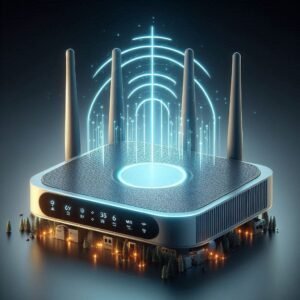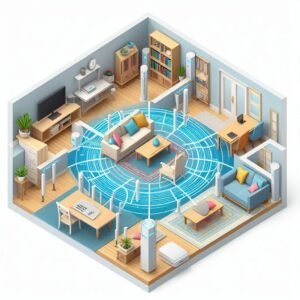How to Set Up Your WiFi 6 Network for Maximum Performance

Introduction
WiFi has become so central to our daily lives that we hardly think about it—until it slows down or fails to perform. From streaming your favorite shows in 4K to handling video calls or powering dozens of smart devices, a robust network can make or break productivity and entertainment at home. That’s where WiFi 6 comes in.
The latest standard in wireless networking (also known as 802.11ax) is designed to cope with the ever-increasing demand for bandwidth, speed, and stability. But simply plugging in a WiFi 6 router is not enough to guarantee top performance. To truly unlock its potential, you’ll need to set up your network strategically.
In this guide, we’ll walk through everything you need to know to set up your WiFi 6 network for maximum performance. We’ll cover router placement, configuration tricks, device compatibility, security, and advanced optimizations that can make a real difference.
How to Set Up Your WiFi 6 Network for Maximum Performance & What Makes WiFi 6 Different?
WiFi 6 takes the best of previous wireless standards and supercharges them with new technologies:
-
Higher Speeds: Capable of reaching up to 9.6 Gbps under ideal conditions.
-
OFDMA (Orthogonal Frequency Division Multiple Access): Breaks up channels so multiple devices can share the same spectrum efficiently.
-
MU-MIMO Enhancements: Supports simultaneous connections to more devices.
-
Target Wake Time (TWT): Helps conserve battery life on compatible devices.
-
Improved 2.4 GHz and 5 GHz Spectrum Management: Better overall stability in crowded environments.
Step 1: Choosing the Right WiFi 6 Router
Your router is the heart of the network, and not all WiFi 6 routers are built the same. When selecting one, consider:
-
Coverage Area: A small apartment may only need a single-unit router, while a larger home might benefit from a WiFi 6 mesh system.
-
Processor and RAM: Higher-end routers can handle more simultaneous tasks, essential if multiple people stream or game at the same time.
-
Available Ports: Look for Gigabit (or higher) Ethernet ports if you plan to connect gaming consoles, PCs, or NAS devices directly.
-
Features: Advanced parental controls, VPN support, or built-in security features could be deciding factors depending on your household needs.
-

Choosing the right WiFi 6 router sets the foundation for blazing-fast performance
Step 2: Strategic Router Placement
Even the most powerful router can struggle if it’s poorly positioned. WiFi signals weaken with distance, walls, and interference, so consider these placement rules:
-
Central Location: Place your router in the middle of your home to distribute coverage evenly.
-
Elevation Matters: Keep the router off the floor, ideally on a shelf or mounted on a wall.
-
Avoid Interference: Stay clear of microwave ovens, cordless phones, thick concrete walls, and metal surfaces.
-
Line of Sight: The fewer obstructions between the router and your devices, the stronger the connection.

Step 3: Optimizing Your WiFi 6 Settings
Most people plug in their router and never touch the settings again. But diving into your router dashboard can unleash significant performance boosts.
-
Enable Both Bands (2.4 GHz and 5 GHz):
The 2.4 GHz band offers better range, while 5 GHz provides higher speeds. Let devices automatically choose the best option. -
Use Separate SSIDs (Optional):
For power users, naming the 2.4 GHz and 5 GHz networks differently can give manual control over which devices connect where. -
Enable WPA3 Encryption:
The latest WiFi security standard makes your network harder to hack and keeps your traffic protected. -
Turn On QoS (Quality of Service):
Prioritize devices like gaming consoles or video call apps to reduce lag and buffering. -
Update Firmware Regularly:
Manufacturers constantly release performance and security improvements—don’t ignore those updates.

Step 4: Device Compatibility
Not all your devices may be WiFi 6 compatible. While WiFi 6 routers are backward compatible with older gadgets, you’ll only experience the full benefits when connecting WiFi 6-capable devices like:
-
Modern smartphones (e.g., recent iPhone and Samsung Galaxy models)
-
Latest laptops and tablets
-
New generation gaming consoles
-
Smart TVs with WiFi 6 adapters
If most of your devices are still WiFi 5 or earlier, you’ll see performance gains due to smarter spectrum allocation, but upgrading key devices will unlock the full speed advantage.
Step 5: Considering Mesh Networking

If your home spans multiple floors or has dead zones, a mesh WiFi 6 system might be your best investment. Instead of relying on a single router, mesh systems use several nodes placed around the house to ensure seamless coverage.
Benefits include:
-
Smooth handoff between nodes with no dropped connections.
-
Consistent coverage everywhere, from basement to attic.
-
Ideal for smart homes with dozens of IoT devices.
Step 6: Minimizing Interference
Even with WiFi 6, network interference can drastically affect speeds. Consider:
-
Channel Selection: Many routers default to automatic channel selection. This works most of the time, but manually picking less congested channels can help if you live in a dense apartment area.
-
Smart Device Load Balancing: Too many IoT gadgets (smart bulbs, plugs, etc.) can bog down your network. Place them on the 2.4 GHz band to free up 5 GHz bandwidth for heavy-lifting devices.
-
Turn Off Old Routers: Running multiple outdated routers or extenders can create interference loops. Upgrade fully to WiFi 6 instead.
Step 7: Hardwire When It Makes Sense
Remember that wired Ethernet is still king for certain tasks. While WiFi 6 is fast, you’ll always get lower latency and maximum consistency with a wired connection. If possible:
-
Plug gaming consoles, desktops, and workstations directly into the router.
-
Use Ethernet backhaul in your mesh system for better stability.

Step 8: Safeguarding Your WiFi 6 Network
Performance isn’t just about speed—it’s also about security. A hacked or overloaded network will slow everyone down. Ensure you:
-
Use WPA3 encryption instead of WPA2 when possible.
-
Change default admin credentials immediately.
-
Disable WPS (WiFi Protected Setup) if you don’t need it, as it can be exploited.
-
Regularly check connected devices to ensure no unwanted intruders are on your network.
Step 9: Advanced Tweaks for Power Users
If you’re comfortable tinkering with more advanced settings, here are some pro-level optimizations:
-
DFS Channels (Dynamic Frequency Selection): These under-utilized 5 GHz channels can provide cleaner bandwidth but may occasionally drop if radar signals interfere.
-
Beamforming: Some WiFi 6 routers allow you to direct signals more efficiently to specific devices. Make sure it’s enabled.
-
Bandwidth Adjustments: Switching to 160 MHz channels can double throughput if both your router and devices support them.
-
VPN Integration: Route select devices through a secure VPN directly from the router.
Step 10: Test, Measure, and Adjust
Finally, setting up a WiFi 6 network isn’t a “set it and forget it” process. Regularly test and fine-tune your setup:
-
Use speed test apps in different rooms to identify weak spots.
-
Adjust antenna angles on routers that have external antennas.
-
Move mesh nodes slightly for stronger backhaul connections.
-
Periodically review device connection distribution between 2.4 GHz and 5 GHz.

Conclusion
WiFi 6 is a game-changer for modern connectivity. It’s faster, smarter, and designed for the device-heavy households we live in today. But the key to unlocking its full potential lies in how you set it up. By choosing the right router, positioning it strategically, optimizing settings, upgrading devices, considering mesh networking, and applying some proven tweaks, you can transform your WiFi 6 network into a powerhouse of performance.
The result? Buffer-free streaming, smooth online gaming, rock-solid video calls, and happy family members who can all be online at once without slowdowns. In short: your WiFi finally works the way it should.
Pingback: WiFi 6 नेटवर्क को अधिकतम प्रदर्शन के लिए कैसे सेटअप करें